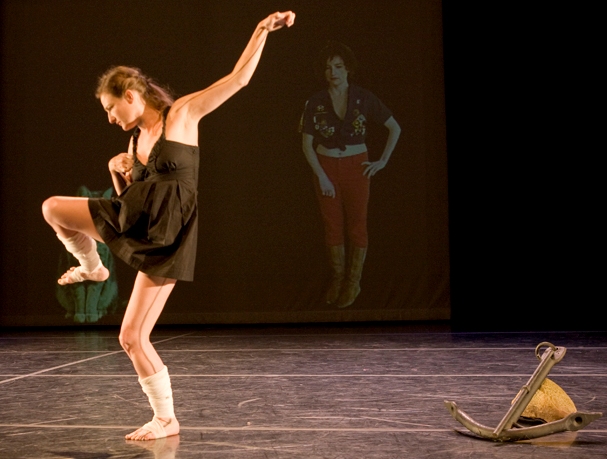Amelia Reeber is a master of timing, and the most compelling moments of her new solo piece come when she displays that skill, matching her bent arms and extended legs to every beat of her accompanying, often dissonant music. She jerks when a guitar wails and moves stiltedly when broken bells sporadically ring. During the brief minutes when the instrumentals—composed by Sam Mickens, guitarist and vocalist for The Dead Science—tend toward lyricism, Reeber’s body responds in kind, demonstrating how fluid and light her dance can be.
The trouble is that less than a third of this hour-long performance is devoted to movement; the rest is multimedia and performance art, an often-overwhelming hodgepodge of hard-to-decipher audio and imagery.
The piece is staged on the mostly open floor of the Erickson Theatre with a sparse set—pyramid-shaped temples, female mannequins hanging in the air—and a floor-to-ceiling screen at the rear. Videos, created by Joe Moore but directed by Reeber, play entirely through this is a forgery‘s first act. At best these images are an attempt at absurdist art; at worst they’re confusing and awkward. The first video—played on an empty stage, before Reeber appears—shows hundreds of digitally animated human sperm racing toward a waiting ova, as the lyrics “You must be used to me/Spending all that sweet wining and dining/I’m fucking you tonight” are sung over an electronic beat. It’s shock without awe, since reproduction and sex are never truly addressed or explained during the rest of the performance.
Once Reeber takes the stage—in a black dress with bandages around her ankles—similarly nonsensical images occupy the screen, one after another: A giant cat watches her dance. A man in a polar-bear costume floats in outer space. A colorfully dressed, wild-haired person who appears to be Reeber’s doppelgänger speaks in captioned sentences (“You can’t be an artist, think of your retirement”). That same doppelgänger, dressed as a doctor, diagnoses Reeber as having the wrong dreams. Reeber interacts with the videos, moving sporadically as if being pulled in 20 directions at once, rolling on the floor, and sometimes laughing manically or making declarations like “This isn’t working for me!”
Only when the videos cease does Reeber begin to move freely and a coherent theme emerge. In the show’s best scene, at the end of the first act, she unwinds her leg bandages by tying the ends to an anchor while dancing mostly en pointe. With each step, twirl, and jerk, she flawlessly unbinds herself.
Reeber reappears for the second act—about 10 minutes long—in a fluid blue dress, and dances effortlessly with no videos behind her. She’s been captive not just physically, the show seems to say, but of her own thoughts and the demands of others.
An excess of freedom can be a drawback, though. Reeber developed her piece using the $10,000 prize from the A.W.A.R.D. Show! at On the Boards in December. That funding gave her room to create something elaborate, but the lesson of the piece may well be that more limitation would do her good.






